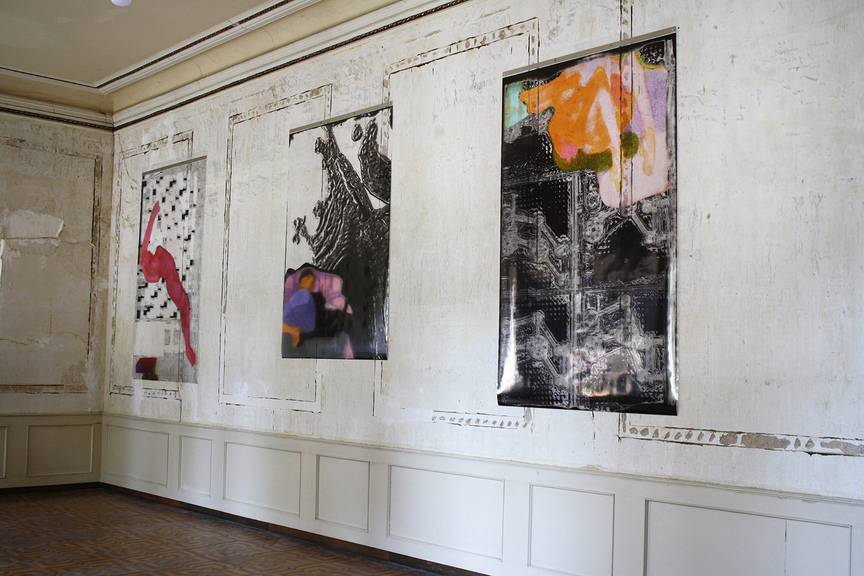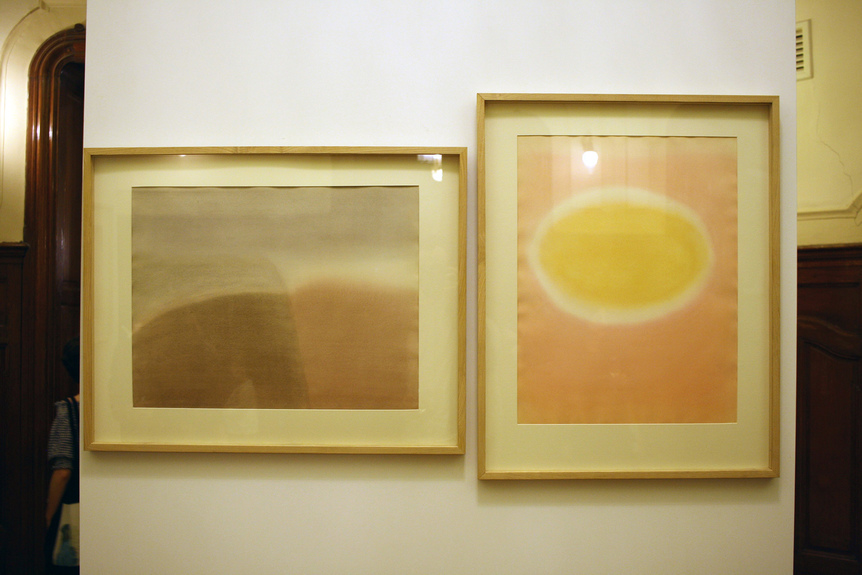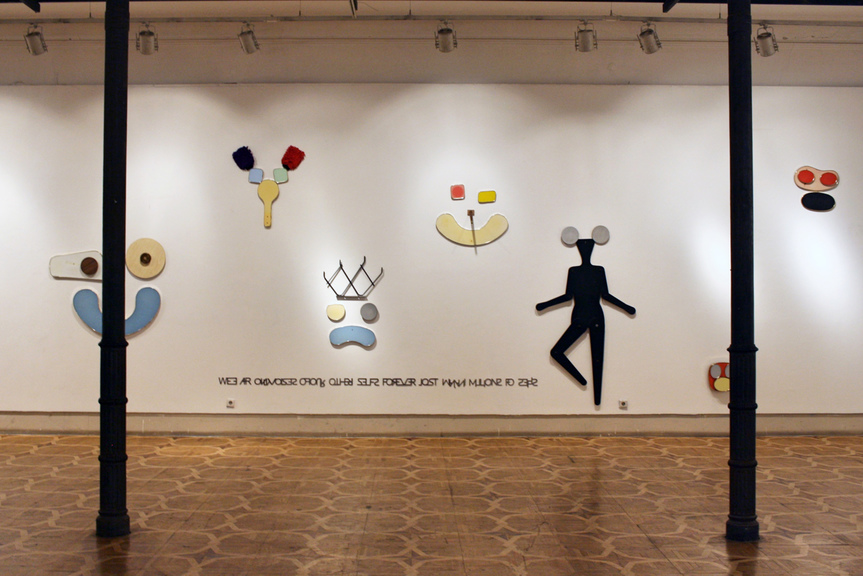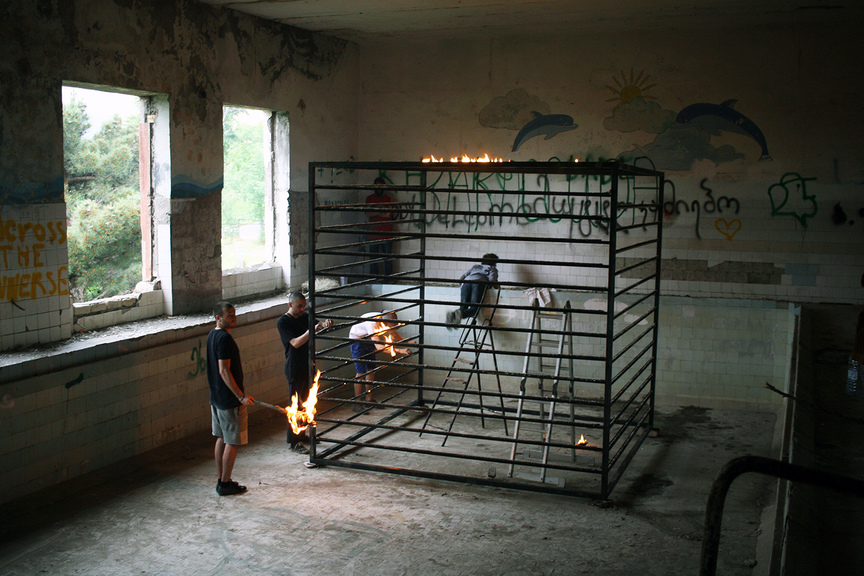
R
E
V N
E
X
T
The exterior of the State Silk Museum in Tbilisi, where one half of the exhibition “Twelve Women Gone Missing” was shown. All photos by HG Masters for ArtAsiaPacific.
With the openings of the inaugural Tbilisi Art Fair (TAF), the alternative “Oxygen – Tbilisi No Fair,” two inaugural projects by the nomadic Kunsthalle Tbilisi, and a gallery newly relocated from Berlin (LC Queisser), Tbilisi in mid-May had a lot going on. Fortunately, these events and others around town also provided showcases for Georgian art of the past, whether mid-century or post-millenium. Most ambitious among them was a two-part exhibition titled “Twelve Women Gone Missing” (a reference to drawings by Maia Naveriani), in which curator Elene Abashidze looked at ten (not twelve) important female Georgian artists born through the 20th century who had left the country. The stated purpose of the exhibition was to question both the narrative of Georgian art history in light of these “missing” figures, and “the notion of belonging” when Georgian art developed while artists were living in cities around the world.
One half of the exhibition was hosted at the State Silk Museum, one of Tbilisi’s many beautiful late-19th-century buildings that has fallen into disrepair—giving it another layer of almost-cliché romantic charm. In a large empty room were paintings on transparencies by New York-based Tamara KE, whose works slipped between the mechanical and gestural just as they did between the abstract and figurative. Inside the museum’s main display space, in a wooden cabinet alongside myriad textile samples, were black-and-white photographs by Keti Kapanadze of the phrases “Touch My” [sic] and “Help My” projected at angles on a flat surface, and, in a central vitrine, several of her text sculptures in nickel, including the word “love” written in curly letters and suspended on one end like a pendulum—collectively suggesting a deep but unarticulated yearning and desire. In another room were Salome Machaidze’s messy, expressive figurative drawings, installed inside display cases next to photographs of mulberry bushes and branch samples. Finally, Multiple Keyholes (2014), a video by New York-based artist Anna KE (daughter of Keti Kapanadze), showed her moving into poses matching the rectangular shapes of the silhouette from the frames of her studio window, in a metaphorical act of contorting the body to rational, rigid structures.
From the Silk Museum—thanks to Irena Popiashvili’s assistants, who hailed cabs for us and haggled with the exceptionally aggrieved taxi drivers—we made it across town to the apartment of Karlo Kacharava, an artist who died in 1994 at age 30, and according to Popiashvili, was the key figure in creating contemporary art in Georgia. A poet and an artist, Kacharava filled notebooks and canvases with gaunt, expressionist figures, reflecting the angst of the Soviet years. He also translated Allen Ginsberg’s beat-poem Howl into Georgian, which might give you a sense of his aesthetic. His works filled the walls of the low-ceilinged rooms of the apartment, where his sister still lives and looks after his legacy. Popiashvili told us that his poetry was republished recently, and he’s become a cult figure among the 20-something literary and creative set in Tbilisi, with certain figures from his drawings appearing on popular t-shirts.
We saw the second part of “Twelve Women Gone Missing” the next day at the beautiful Art Nouveau building of the Writers’ House. There were abstract, tantric-like watercolors by Vera Pagava (1907–1988), who emigrated to France in 1923, where she spent the rest of her life, even representing her adopted home country with this series at the 1966 Venice Biennale. In an adjacent room were two paintings by Thea Gvetadze, Malanchamala and Don Juan (both 2006), which were simultaneously unnerving and cryptic, like much expressive figuration in Georgia. In an ornate room with red and gold wallpaper was an untitled 2015 oil-stick-on-canvas abstraction in reds and yellows by the late Tamuna Sirbiladze (1971–2016), which was almost camouflaged by the opulent setting. Upstairs, Sophio Medoidze’s video Jackals and Drones (Chronicles of a Summer) (2016–18) appeared to be meta-documentation of trying to film in historical caves. The exhibition’s titular drawings by Maia Naveriani were in a large, ballroom-like space, including three drawings titled Twelve Women Gone Missing (Women with Life Belt, Red Door and Badminton, all from 2001)—and outside in the garden, hanging from the roof of the building were the two large banners, Early Christian Art and Architecture and Islamic Art and Architecture (both 2005), humorous for their odd combination of serious titles printed in colorful block letters, with outlines of clouds and bird wings in the background. I don’t know the Georgian art-historical narrative well enough to appreciate the ways in which these artists have previously been neglected, but it was evident from these brief glimpses of their respective practices that these are interesting and important figures, regardless of whether the context is Georgian or international.
That question—over the appearance, and coherence, of a national art scene that exists partly in diaspora—came up in the panel discussion at TAF in a program of talks that Popiashvili was organizing for the fair. Tbilisi art critic (and ArtAsiaPacific Almanac correspondent) Lali Pertenava led a conversation with anthropologist and curator Francisco Martinez, Kate Sutton from Artforum, and myself, about critical writing around the topic of centers and peripheries. Pertenava rightly observed that the art fair itself was about articulating and legitimizing an art infrastructure in Tbilisi—establishing a center of sorts. Martinez proposed that what we’ve come to realize recently is that centers find they cannot even understand the peripheries, but they also realize that they cannot ignore them any longer. Sutton gave the example of how artists like Taus Makhacheva, who comes from Dagestan,end up being asked to perform their regional identities and histories in “centers” like Moscow or the international art world. I broached a similar concern that artists in emerging contexts often appear to be “self-orientalizing,” by exaggerating national characteristics or heritage, in order to be legible to the international art world, which generally has only a limited knowledge or stereotypes of other cultures—though, admittedly, it’s a fine line between representing and exploring items of cultural significance and peddling in the clichés about them.
The same night of the Writers’ House opening of “Twelve Women Gone Missing” was the launch of a solo showcase of Keti Kapanadze titled “8 Minutes,” curated by Noemi Smolik and organized by the Georgian National Museum and Contemporary Art Gallery at Tbilisi History Museum, formerly a caravanserai and then an arcaded market. Many of Kapanadze’s works deal with language, in sculpture installations of text, including wall-pieces done in iron (presumably doused in something) that she sets on fire, leaving charred streaks on the wall. One of these, represented by a photograph, reads: “In a second unexpectedly without permission without control by chance without reason as a glance as a spark as a thrown stone in one brief look.” The act of looking becomes one of reading, a simultaneous decoding of words and visual codes. Another, cast in metal, between rows of red and silver squares and blue stripes, spells out: “Everyone can express feelings to a certain extent because they first must be transformed into signs signs into words words into notions and notions then again into feelings.” Other wall sculptures are made from rounded, painted wooden objects—such as mid-century tabletops or table legs—into assemblages vaguely resembling human forms. Though much was abstracted, there was a sense that the work too was about the translation of one kind of language (“design”) into the figurative of “fine art.” Rather humorously, a side entrance into the gallery was adorned with a gray-scale poster of a male underwear model. It seemed like a punk-ish, post-modernist joke of the pre-millennial era, but made sense too in the context of the show, riffing as it did on an entirely different kind of language or communication—namely, advertising—that could be juxtaposed with Kapanadze’s more classically avant-garde inquiries.
While artists like Keti Kapanadze and others of “Twelve Women Gone Missing” had all emigrated for different reasons over the past few decades, I had met many Georgian artists who were returning, either more frequently or permanently. Popiashvili herself is one of those people, who, after running a gallery in New York, is back, running an art school, a gallery, a kunsthalle and caring for an artist’s estate. The even younger generation—born in the late 1990s—are the beneficiaries of this cultural expansion, though they hardly seemed to need encouragement.
We visited an exhibition of works organized by many of Popiashvili’s students from the Painting Department at Free University. Titled “And,” the showcase took place in the hilly Nutsubidze district, an area where many artists used to live, at an abandoned German school. The students and other young artists had spent two weeks just cleaning out the rubble from the derelict building. In a parking lot outside, they had set up a long table, where they were serving bread and cheese, accompanied by jugs of amber wine, to entice adults and children from the surrounding buildings. Inside the two-story space were dozens of projects, with works in every available room: Bubu Mosiashvilihad installed swatches of fabric in the floor for 9 Months and 76 Days; Sandro Anchabadze suspended a large tree branch in the middle of a room by ropes. Salome Chigilashvili, whose work had wowed visitors to “Oxygen – Tbilisi No Fair,” had installed squares of plaster connected by a zipper on the walls in various locations; Popiashvili excitedly showed us how you can unzip the strap to reveal a roughly one-centimeter-wide hole in the wall. One work even featured a live sheep cowering in a room cast in a dark red light—which might have invited accusations of animal cruelty in another context.
I was impressed by first-year student Mari Kalabegashvili’s installation I Grew Up Here (2018), featuring child-like chalk drawings on the floor of a room (made by her friend’s ten or eleven-year-old sister), on top of which she placed a grid of syringes that she had found while they were cleaning out the building. She explained that drug use has been, and remains, a serious problem in Georgia, and that the government had imposed draconian punishments for use and possession, which people are now trying to reverse or modify with more progressive ideas of treatment and therapy. A campaign called the White Noise Movement has been attempting to loosen these punishments. Meanwhile, several young clubbers in Tbilisi have died in recent months from taking bad batches of the designer drug mephedrone (known on the street as “bath salts”); the government justified the raids on Bassiani and Café Gallery in mid-May under the pretext of arresting drug dealers.
Setting sculptures on fire turned out to an unexpected theme of my time in Tbilisi. In a large room that looked like it might have once been a swimming pool was a metal cage structure more than three meters in height that people wielding flaming torches were attempting to set alight. Before they were able to succeed (as a thunderstorm broke over the socialist housing blocks) we were called into a large space, probably once a gymnasium, for a fashion show by Liza Bokeria. Spotlights illuminated small piles of rubble as student models of both genders marched to the sounds of electronic music through the space wearing black-and-white outfits, with large geometric forms hanging around their necks. It may have gone on a little too long, but there was a collective energy among the models and the crowd. That mixture of elements—in an abandoned space cleared of rubble, of a collective, self-organized energy and enthusiasm—came to define my first impressions of Tbilisi.
This is the second part of a two-part blog. Part 1 can be read here.
HG Masters is editor-at-large of ArtAsiaPacific.
To read more articles by ArtAsiaPacific, visit our Digital Library.










